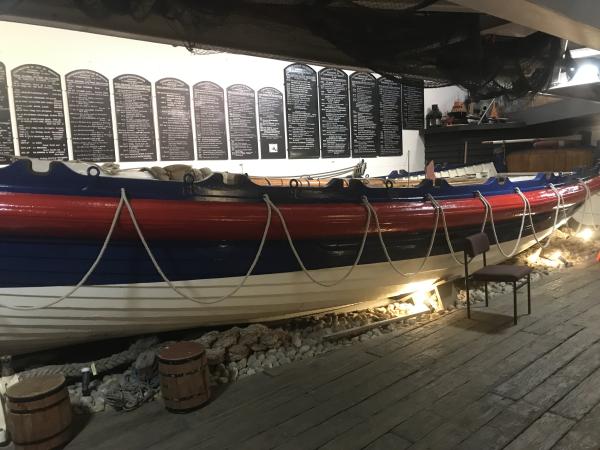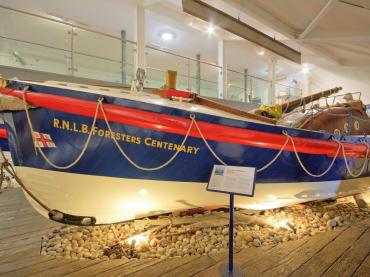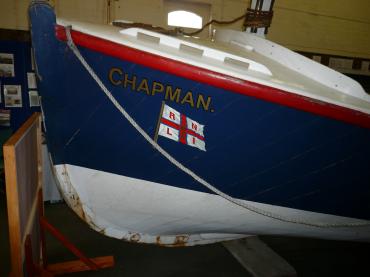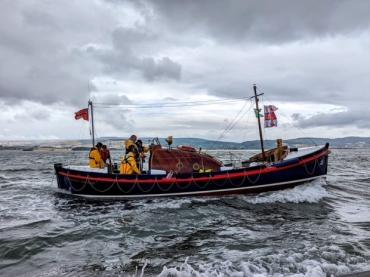

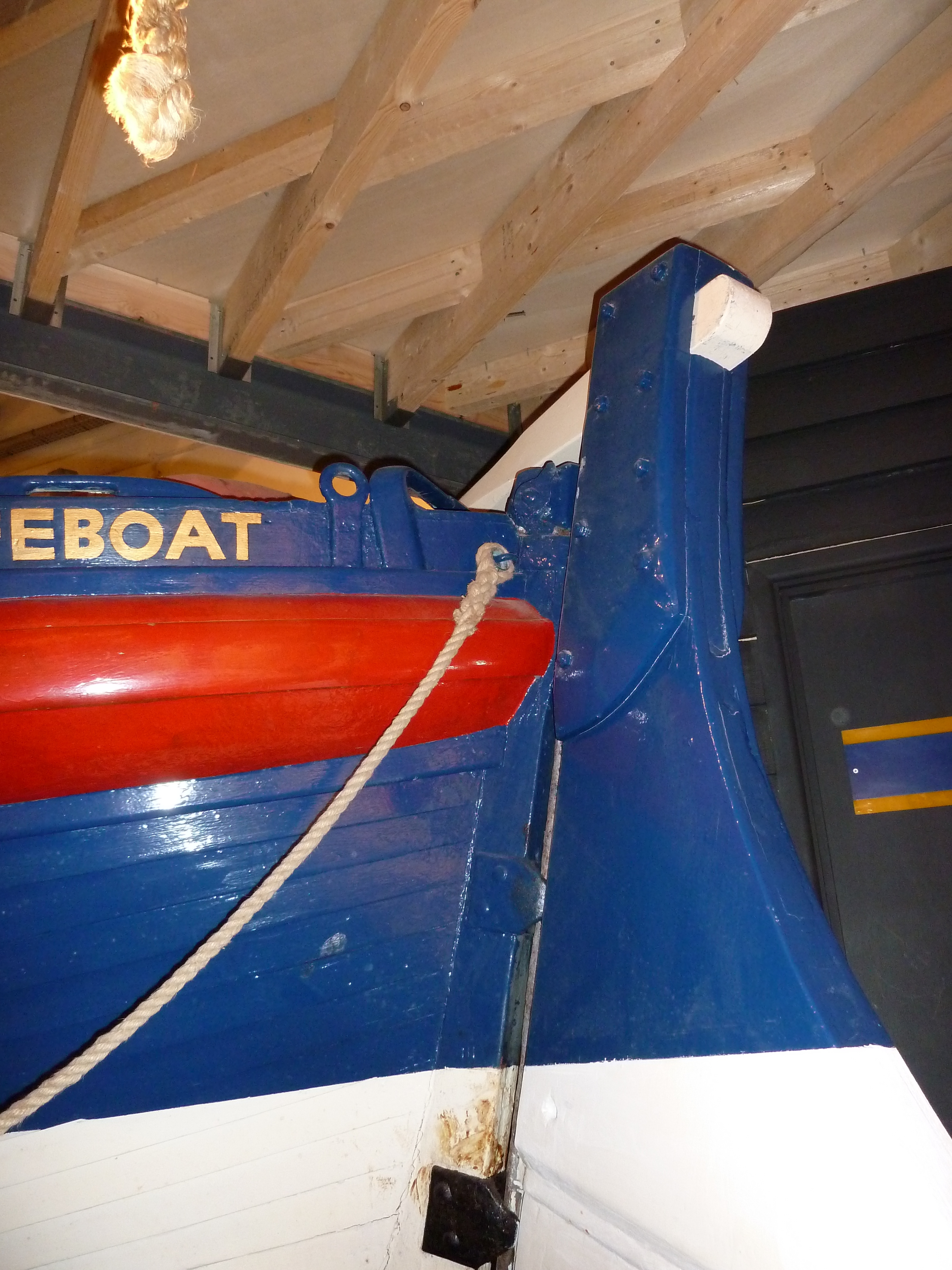
Details
Construction
Dimensions
History
J C MADGE is a Royal National Lifeboat Institution Liverpool class lifeboat, built by Thames Ironworks in London between 1903 and 1904. Her yard number was TK 68 and her lifeboat number was 536. She was built with a legacy from James C. Madge of Southampton and cost £1436. She was in service from 13 December 1904 to June 1936 and arrived on station at Sheringham, Norfolk on 2 December, having sailed around the coast from Blackwall. She was officially named on 13 December and housed in a newly built corrugated iron boathouse at the Old Hythe.
Her coxswain from 1904 to 1914 was William ‘Click’ Clark. He was replaced in 1914 by Obadiah Cooper and then, in 1924, James Dumble took over for the rest of her service. The boat was carriage launched, needing at least thirty men to haul her out to the sea. Where possible, she was then rowed through the surf, but if this was too difficult, she was hauled out using the haul-off warp - a thick rope anchored offshore and fixed at the beach end by the lifeboat house. In her career, J C MADGE was launched thirty-four times and is credited with saving fifty-eight lives. She also frequently stood by local fishing boats, ready to give assistance if necessary. Her most notable rescue was that of SS ULLER of Bergen on 24 February 1914.
The vessel was en route from Sunderland to La Pallice with a cargo of coal and had foundered on a sandbank. Amid snow storms and strong winds, J C MADGE escorted SS ULLER to the Humber Estuary fifty-three miles away. J C MADGE was converted to a family cruiser on leaving the service, when she was replaced by FORESTER CENTENARY. Her hull is clinker built, fastened with copper nails and roves. She has a pointed bow with a plumb curved stem and a pointed stern. Her two timber masts are rigged with lug sails. She was rowed by sixteen oars, had two drop keels and two water ballast tanks.
J C MADGE is the only forty-one foot Liverpool class lifeboat ever to be built and following restoration to her original appearance by March 2008, she is now on view to the public at The MO, Sheringham.
Significance
- What is the vessel’s ability to demonstrate history in her physical fabric?
Evidence for designs, functions, techniques, processes, styles, customs and habits or uses and associations in relation to events and people. How early, intact or rare these features are may impact on significance.
JC MADGE was built between 1903 and 1904 at the Thames Ironworks in London as an RNLI Liverpool Class lifeboat. Shehas a clinker-built hull fastened with copper nails and roves, a pointed bow with a plumb curved stem and a pointed stern. She was fitted with two timber masts, rigged with lug sails, and would have originally been rowed by sixteen oars. Two drop keels and two water ballast tanks are fitted on the vessel. After its period of service with the RNLI, JC MADGE was converted to a family cruiser. JC MADGE is the only 41ft Liverpool class RNLI lifeboat ever to be built and incorporated several features requested by local fishermen. She was conserved back to her original appearance in 2008.
- What are the vessel’s associational links for which there is no physical evidence?
Associations with people or places. Off-ship research.
The vessel was named after James C Madge of Southampton and served in Sheringham, Norfolk for 32 years from 1904 until 1936 giving her a strong local significance to this area. During service, JC MADGE was launched 34 times and saved 58 lives, including several rescues involving international shipping. Her most notable rescue was of the SS ULLER of Bergen on the 24 February 1914. This vessel was en route from Sunderland to La Pallice with a cargo of coal and foundered on a sandbank. Amid snow storms and strong winds, JC MADGE escorted SS ULLER to the Humber Estuary fifty-three miles away. Throughout her career, JC MADGE also regularly stood by local fishing boats, ready to give assistance if necessary. JC MADGE was recorded on the National Register of Historic Vessels in 1999.
- How does the vessel’s shape or form combine and contribute to her function?
Overall aesthetic impact of the vessel, her lines, material she was built from and her setting. Does she remain in her working environment?
JC MADGE’S larger size was an advantage when coming to the aid of vessels off the Norfolk coast and she handled well, with a good sailing ability and pulling power. Her capacity to hold a large crew, with 16 people rowing at once, was especially helpful in difficult weather conditions. The two drop keels and water ballast tanks were designed to suit the launching process for the lifeboat and support its rescue work. JC MADGE is now on public display as a static exhibit at the Mo, Sheringham, in the area where she once worked.
Source: NHS-UK team, January 2024.
Sources
Farr, Graham, Lists of British Life-Boats Part 1: Non Self-righting, Pulling & Sailing Boats 1775-1916, 1983
Own this vessel?
If you are the owner of this vessel and would like to provide more details or updated information, please contact info@nationalhistoricships.org.uk


